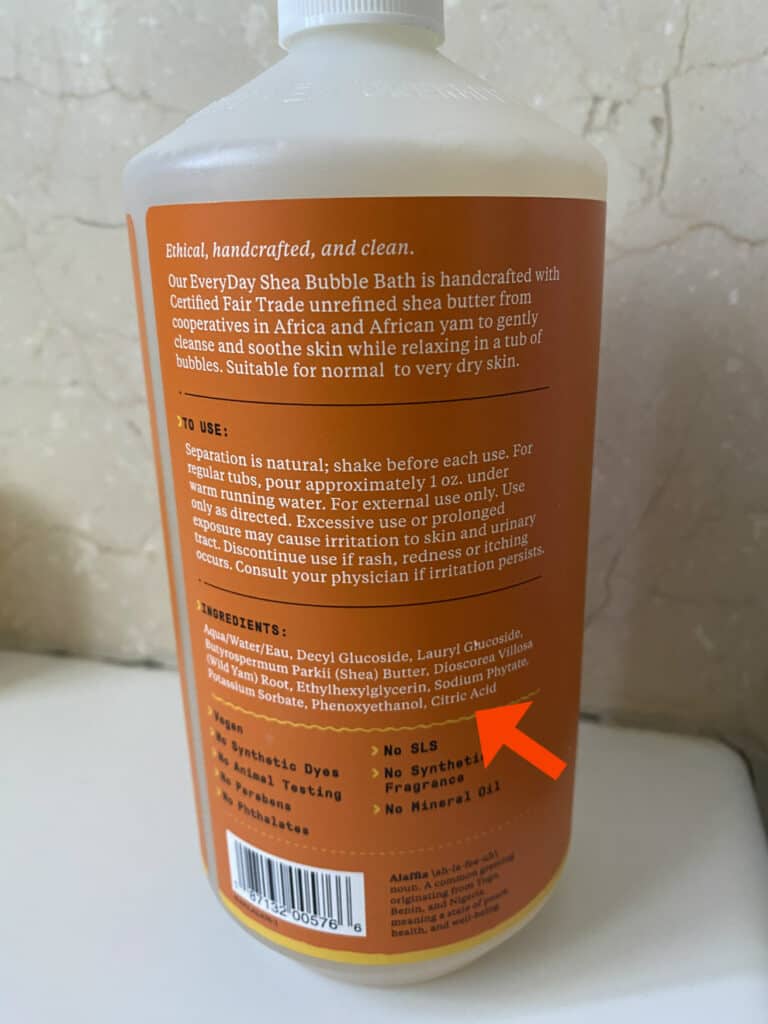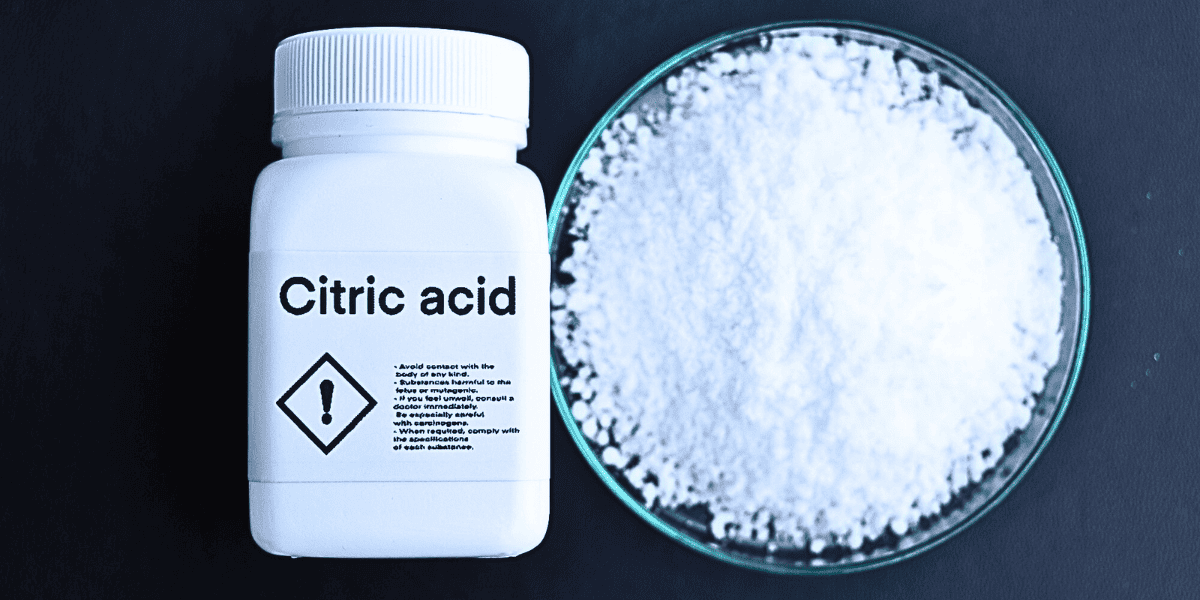EDITOR’S SUMMARY: How many times have you noticed an ingredient on a food or cosmetic package label, and not knowing what it was, “threw caution to the wind” and ingested it or used it topically regardless? Research has shown this preservative—citric acid—is problematic from production to consumption, and is linked to a number of ill health conditions. Perhaps this is an important substance to become familiar with before your next grocery store run or online shopping jaunt.
Written by Carter Trent
Edited by Nicki Steinberger, Ph.D.
Imagine you’re at the market to pick up food for your family’s dinner. Thinking of making pasta tonight, you grab a jar of tomato sauce and scan the ingredients. Among the easily-recognizable tomatoes, basil, and extra virgin olive oil is citric acid. What is this bewildering ingredient exactly, and why is it in tomato sauce, and so many other products?
If you glance at the ingredients in other packaged and processed foods, you’ll often see citric acid listed. It’s pretty ubiquitous in your food supply. In fact, citric acid is one of the most common food additives in the world. Despite the citrus-related name, citric acid harbors a dark side, and it’s important to understand why citric acid is so prevalent in your food system. Citric acid’s purpose is to act as a preservative. As the name suggests, it’s acidic, and that allows citric acid to prevent the growth of bacteria, mold, and other harmful microbes in foods and beverages.
In addition, citric acid is used as a flavoring agent to give food a bit of a tangy taste; for example: the acidic ingredient needed in particular cheeses such as paneer. It’s also used as a chelating agent to prevent food contamination from the metal in manufacturing machinery. For these reasons, manufacturers insert citric acid into a wide range of foods and beverages.

It’s found in ice cream, wine, and soft drinks, including popular brands such as Sprite and Pepsi. Citric acid is added to many cosmetics, cleaning products, and yes … bubble bath. You’ll also see it in nutritional supplements, to help with nutrient absorption. That said, approximately 70% of the citric acid produced today is used in the food industry.
Citric acid was first discovered by chemist Carl Wilhelm Scheele in 1784, who extracted it from lemon juice. Citric acid exists in many other citrus fruits as well, hence the name, and it was originally mass-produced from lemons. The U.S. Food and Drug Administration (FDA) designated citric acid with the label “generally recognized as safe” (GRAS). This tells manufacturers it’s okay to use citric acid in food.
So given its GRAS status and fruit origin, citric acid has to be okay to consume, right? Sadly, the GRAS designation doesn’t mean the FDA tested the food additive for safety. Although the 1958 Food Additives Amendment requires FDA approval for new food additives, it exempted any that were in use prior to 1958, which includes citric acid.
But the real problem lies in how citric acid is produced today. Despite the name, the citric acid added to your food and cosmetics does not come from citrus fruit, or any fruit for that matter, and thus contains no vitamin C. In 1919, a process to make citric acid using the black mold, Aspergillus niger was discovered, and this process is what’s used today.
After all, it’s far cheaper to grow mold than to use citrus fruit. About 99% of the citric acid produced today comes from microbial processes, primarily using a mutated strain of Aspergillus niger. Because of its long history as a food additive, and lack of evidence of harm, the FDA assumed this form of citric acid, referred to as “manufactured citric acid (MCA),” was safe for human consumption without scientific studies to back up the assumption.
Research published in 2018 shows citric acid produced from Aspergillus niger is harmful to your health. The mold contains toxins such as ochratoxin A, which can cause kidney failure and other diseases, including cancer. Ochratoxin A damages your DNA, and scientists believe that’s what kicks off the development of cancer. Ochratoxin A is so dangerous that the FDA monitors for it in our food supply.
Taken from “Potential role of the common food additive manufactured citric acid in eliciting significant inflammatory reactions contributing to serious disease states: A series of four case reports”:
“We recognize the limitations of the level of evidence from our four case reports. We cannot conclusively affirm that MCA is the causative factor in the subjects’ inflammatory symptoms. However, our findings demonstrate a significant likelihood that MCA may be the culprit and are suggestive of valid concerns which warrant proper double blind studies to determine presence or absence of harm.
We hypothesize that since MCA is a product of Aspergillus niger, there are contaminants from the production process that remain in the final product. We hypothesize that there are proteins or other by-products of the A. niger or substances from the manufacturing process which remain in MCA after its production process and these lead to an inflammatory process, and possibly unlike natural citric acid, MCA is highly inflammatory itself.”
Yet ochratoxin A was found lurking in manufactured citric acid according to one research study. This study looked for ochratoxin A in samples of Aspergillus niger created in China. China is the largest producer of manufactured citric acid, while the U.S. is the largest consumer of it. The study discovered the frequency of ochratoxin A toxin ranged from 13% to as high as a third of the Aspergillus niger produced in China.
The Aspergillus mold is found both outside and indoors, and is so common that most people breathe in mold spores daily. Over 100 different species of this fungus exist, and the bulk of them are said to be harmless to humans. However, according to the U.S. Centers for Disease Control and Prevention (CDC), Aspergillus niger in particular is known to cause a variety of illnesses.
The mold affects everyone differently, and may depend on the condition of your health, although citric acid is notorious for inducing coughing regardless of your current state. You may experience an allergic reaction, or if you have a weakened immune system, cystic fibrosis, or asthma, the Aspergillus mold can create wheezing, coughing, shortness of breath, and a respiratory infection that can spread to other parts of your body.
If you have asthma, you could experience worsened symptoms due to this mold. A study from Iran confirmed asthma patients were sensitive to Aspergillus niger, and the Aspergillus mold may play a role in the development of asthma in the first place. Aspergillus niger also produces ear infections, called otomycosis. The Aspergillus mold causes 90% of otomycosis cases.
From Europe PMC, “Otomycosis: clinical and mycological study of 97 cases.”:
“Most cases were unilateral (90.7%) and the main predisposing factors associated with the disease were trauma (secondary to the constant scratching) and the use of topical antibiotics. Major causal agents were several species of Aspergillus (63.9%), of which Aspergillus flavus was commonest (26%), followed by Candida albicans (26.8%) and Aspergillus niger (21%).”
One study examining manufactured citric acid found that it could cause joint and muscle pain, abdominal cramps, and inflammation as a result of the body fighting off Aspergillus niger’s toxins. The study suggested continued exposure to Aspergillus niger through citric acid consumption created low-grade inflammation in your body that remains as long as you continue to expose yourself to manufactured citric acid. However, how much exposure is too much is not known since no scientific studies have evaluated the safety of manufactured citric acid when ingested over time.
The low-grade inflammation is a sign of your immune response reacting to the infection. But when this inflammation becomes chronic, lasting months or years, it can lead to a range of ailments such as myalgia, arthritis, asthma, and more serious conditions including type 2 diabetes, heart disease, and cancer.
And with demand for MCA projected to grow over the next decade, diseases associated with chronic inflammation are also expected to rise. Globally, about 60% of people die from chronic inflammatory diseases, which makes sense when you consider citric acid is just one of the many food additives causing inflammation. The list includes, but is not limited to monosodium glutamate (MSG), artificial sweeteners such as aspartame, and artificial food colors.
Another way manufactured citric acid hurts your health is by damaging your teeth. The acidic nature of citric acid eats away at tooth enamel. Combine citric acid’s acidity with the sugar in soft drinks, and soda delivers a particularly potent one-two punch to your oral health. Because your mouth is filled with microorganisms, some beneficial and others harmful, sugary foods and drinks provide an energy source to the harmful microbes. This encourages the production of plaque, an acidic substance that erodes your teeth’s enamel, causing tooth decay and gum disease. The acidity you’re exposed to through various foods and drinks containing citric acid only exacerbates the damage from plaque.

Production
A major concern with manufactured citric acid is how it’s produced. To get the Aspergillus niger mold to grow, it’s fed sugar in the form of cornstarch, which is derived from corn. Over 90% of corn is genetically-modified, meaning human intervention altered the DNA of natural corn to produce desired characteristics such as disease tolerance.
Of course, citric acid isn’t your only exposure to corn since it’s widely used in the food supply. For instance, high fructose corn syrup, used in a wide variety of foods and beverages is derived from corn, and is known to cause fatty liver disease, a precursor to cirrhosis of the liver, as well as obesity and type 2 diabetes.
Adding to this is that Aspergillus niger itself is genetically-modified through the use of gamma radiation, which is dangerous to humans. Research studies show a number of potential impacts from genetically-modified food, ranging from allergic reactions to toxicity exposure, and even contributing to increased cancer risk. With cancer rates rising, even for those under 50 years of age, it’s best to do what you can to reduce this risk.
Given how your body may respond to long-term exposure from MCA, the ideal solution is to avoid any food, beverage, or cosmetic containing citric acid. After all, your health is already subject to a substantial toxic load from various chemicals injected into foods, such as dyes, emulsifiers, and anti-caking agents. Do what you can to reduce your exposure by avoiding as many of these types of ingredients as possible.

You Must Be a Very Good Investigator
Granted, it’s not easy to avoid citric acid given its widespread use in your food supply, but it’s possible. Here are some key actions you can adopt:
~ Start by reading ingredient labels so you can choose foods that do not contain citric acid. You can also do research online since many food, beverage, and cosmetic manufacturer websites show the ingredients of their products.
~ If you take nutritional supplements, you may find they contain citric acid—usually under “other ingredients.” If so, search through a variety of other brands, and find those that go the extra mile for your health. Investigate whether food-based supplements, which are formulated from concentrated forms of food, may serve as an alternative without the citric acid.
~ Your eating habits may need to change as well. Many sodas use citric acid as a preservative and flavor enhancer, so check your favorites, and consider switching beverages accordingly. Even candy can contain citric acid, particularly those with a sour flavor, and caramel, where it’s used to prevent crystallization.
~ Reduce dining at restaurants, and increase your home-cooked meals so you can control what ingredients go into your food. As part of cooking at home, do your best to avoid processed and factory-farmed meat. This includes sausage, bologna, and other deli meats that frequently contain citric acid as a preservative.
~ Citric acid is also added during the processing of meat, sprayed onto carcasses in an effort to improve food safety from pathogens. In this capacity, citric acid is considered a “food processing aid,” which the FDA allows manufacturers to leave off the list of ingredients. Therefore, you won’t know if the meat you buy contains citric acid. One option that may not entirely eliminate your exposure to citric acid, but minimizes consumption of toxins found in factory-farmed animals, is to opt for responsibly-sourced meat, such as organic, grass-fed, and grass-finished beef.
~ Consider avoiding packaged fruits and vegetables, and prepared salads at the grocery store. To prevent these items from turning brown during transport to the store, plus the time spent lingering on the shelf, manufacturers spray the pre-packaged produce with citric acid, which is known to possess anti-browning attributes.
Instead, go to a farmers market to buy fresh, unprocessed, organic food, and be willing to ask vendors questions about sourcing. This can be a useful approach to reduce your citric acid exposure. The more you steer clear of packaged and processed foods, the greater your opportunity to keep MCA out of your diet.
~
Published on January 18, 2024.
To contact A Voice For Choice Advocacy, please email media@avoiceforchoice.org.
If you would like to support the research and health education of AVFC editorial, please consider making a donation today. Thank you.

